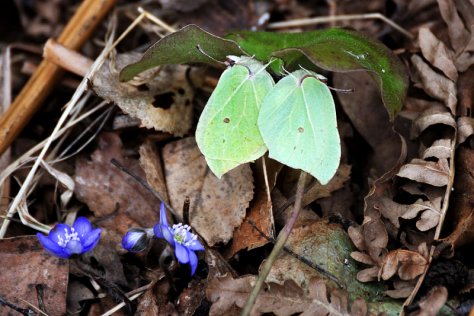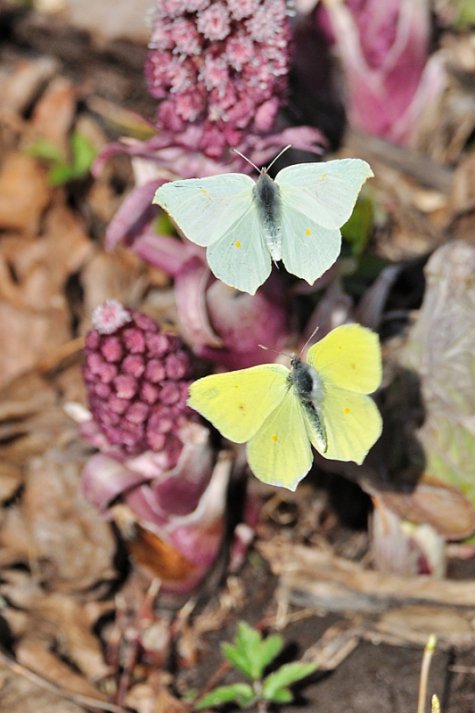The brimstone is our most longlived butterfly
Text and photos Rein Kuresoo, www.animalcity.eu
Translation: Liis
The English think that the word butterfly may originally come from this species (now brimstone). They are not quite certain, but in medieval myths witches transformed themselves into butterflies, in order to go and steal butter - some butterfly species like to circle around cream jugs and butter churns (from this too the German word for butterfly, schmetterling – the word Schmetten has come into High German from the Slav smetana (now sour cream; originally meaning “sweep off”); the Middle High German Molkendiep / milk thief/ and Low German Botterlicker /butter licker/) have similar roots. The brimstone was called the butter butterfly in Estonia too; only in scientific usage the name was confirmed as the official name of a related species.
That seeing a brimstone in spring means a golden summer can well be a fancy of damsels with German upbringing from the Estonian awakening era. There was also a belief that a brimstone as the first seen butterfly in spring would be a sign of butter in abundance to come. And what better to wish for in early spring when food was at an end for both people and creatures and milk from the cows had run dry than being ”in butter”? – that there would be enough butter for a butter hole in the porridge, on your chunk of bread, for the tatties, on your nosetip and between your toes. In North-West Estonia and the islands the first brimstone of the year was fed to the cows, so that the prediction would surely be fulfilled.
Brimstone imagos hatch in mid-summer; they do not wear out their wings much then, but go to rest. The colder the weather becomes in autumn, the more eagerly male brimstone butterflies flutter about – of course only on sunny days. The spot where a brimstone still manages to flap around in late autumn must be warmer than the surrounding environment; here snow disappears faster in spring too. The brimstone sleeps where it drops down in autumn, and the male brimstone dropped where the sun was shining even in autumn. A wintering brimstone withstands up to 20 degrees of cold, although under the snow cover the temperature should generally stay at some degrees of minus. The cells of a wintering butterfly will not freeze completely, the high levels of glycerol, sorbitol and proteins keep the cell liquids fluid as an antifreeze would, even when the butterfly is wholly covered by frost on the outside. So the brimstone leads the dream life of people who hope to find help to prolong their lives from cryogenics. Until now however there is good reason to believe however that at least all humans frozen until now will never stretch their wings.
Such a winter resting state or diapause requires a quite subtle physiological tuning from the butterfly. The first brimstones however wake as soon as the sun melts out the first snow-free patches on the forest floor. The sun warms the black body of the brimstone, and the butterfly uses its lemon-coloured wings as an air conditioner. However carefully you search, the first fliers are all molten-butter-yellow males. On warm days they are surprisingly active – they can be seen circling into the heights on chasing each other, and drinking nectar from willow catkins and colt’s-foot flowers. It is surprising because they must not destroy their physiological frost resistance by the first flights in the first warm days – spring is a fickle season, and many cold days and even colder nights still lie ahead. The brimstones must again and again congeal in the withering grass for shorter or longer periods, and wait for warmer times to return. Even a splash of snow slush or rain on its back doesn’t bother it – if only the rays of the sun will reach to warm it up again.
The margarine-coloured female butterflies, the sight of whom was rather interpreted as a bad omen, will not show themselves yet, luckily for the superstitious. The females will not congeal in the last patch of sun in the autumn, but early already look for a sheltered and moist spot for their winter rest. Thus their sleep also lasts longer in spring, and they usually wake up at the end of April or even in May. The females are immediately ready to mate and this the males who have already been fluttering around for two-three weeks, have been waiting for. After a brief flight together into the spring sky the mating follows, and if all proceeds according to the ancient evolutionary scenario, no female brimstone should be a virgin any more a few hours after waking up.
A mated female brimstone will not look for more relationships, and shrugging off late suitors, she will fly on to a still leafless alder buckthorn or buckthorn branch. The larvae grow fast and the pupa stage and hatching of a new butterfly will not take long. The waking up of the female must be timed precisely so that the eggs will not remain too long in the power of the capricious spring weather. The last brimstones that had survived the winter will end their life cycle around Midsummer; already in mid-July young butterflies with fresh wings can be seen. Although the usual life span of a brimstone imago is 11 months, 13 months have been registered as maximum life length. No imagos of Estonian butterfly species live longer than this.










